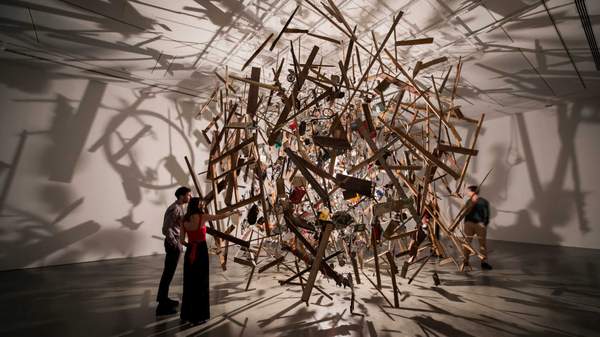Overview
In the early 90s, British artist Cornelia Parker decided to blow up a garden shed. She approached the British Army (who were more than happy to oblige), and together they detonated an explosion that saw 2000 household items fly across several fields in the countryside. Fragments of wood, broken bicycle wheels and a shattered violin — along with thousands of other objects — were collected by the officers, and Parker reconfigured the shed, suspending objects from the ceiling around one central lightbulb. That artwork, Cold Dark Matter: An Exploded View (1991), is now considered Parker's most famous work, and it's currently casting haunting shadows across the gallery walls at the MCA this summer.
The major exhibition, which spans three decades of the artist's career, has four large-scale artworks that transform the gallery's rooms. War Room (2015) is like walking into the Twin Peaks red room, except the blood-red walls are crafted from discarded strips of paper sourced from a Remembrance Poppy factory in London. Parker has created a tent-like structure with 'absent poppies' that's as much about honouring those who've died in conflict, as it is about the duality of war and peace.
Showing both sides of the story is something Parker plays with a lot in her work. Another large-scale piece, Magna Carta (An Embroidery) (2015), is a 12-metre-long hand-stitched version of the Magna Carta Wikipedia page. Parker created the work to commemorate the 800th anniversary of Britain's earliest democratic document, and she invited 200 people from both sides of the law to embroider a panel — including notable whistleblowers Julian Assange and Edward Snowden, Pulp's Jarvis Cocker (why not?) and current prison inmates. When you look closely you'll see coffee stains from those who worked from prison — and underneath you'll see a mirrored reflection of the back of the work.
There's also a satisfying violence to Cornelia Parker's practice. She's shot dice through a dictionary, precipitated a handgun and chopped a toy Oliver Twist in half using the guillotine that beheaded Marie Antoinette. She also steamrolled a collection of silver (sourced from car boot sales) to create another full-room installation, Thirty Pieces of Silver (1988–89). The 30 suspended circles of silverware represent a Bible story of betrayal — and there's a palpable sense of dread when the pools of brass and silver glisten and move with passing air.
Though the larger works in this exhibition, part of the tenth Sydney International Art Series, are the ones you'll Instagram, there's a lot of joy — and foreboding — to be found in Cornelia Parker's smaller artworks. One of our favourites is News at Five (Terror-ble Joke), News at Seven (Chilling), and News at Ten (Bathtub Terror) (all 2017) — three blackboards covered with chalk writing from a five-year-old, a seven-year-old and a ten-year-old. Each child has captured the essence of televised news reports and you can make out words like 'monster', 'nukes' and 'Trump in a grump'. All terrifying and amusing at the same time.
Cornelia Parker is the first major presentation of the her works in Australia, and the exhibition runs until February 16. But don't leave it until 2020 before you visit, as you'll want to return to delve deeper into the playful violence behind one of Britain's most important female artists working today.
Images: Installation views of Cold Dark Matter: An Exploded View (1991); War Room (2015); Subconscious of a Monument (2001-05); Cold Dark Matter: An Exploded View (1991); and Thirty Pieces of Silver (1988–89). All images courtesy of the artist, the MCA and Frith Street Gallery, London. Photos by Anna Kucera.
Features
Information
When
Friday, November 8, 2019 - Sunday, February 16, 2020
Friday, November 8, 2019 - Sunday, February 16, 2020
Where
Museum of Contemporary Art Australia140 George Street
The Rocks
